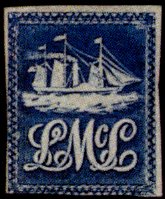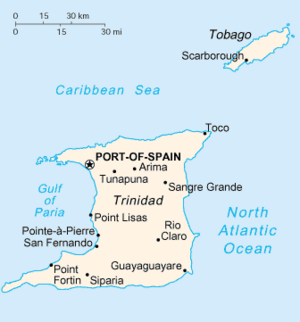Lady McLeod facts for kids
Quick facts for kids Lady McLeod |
|
|---|---|
 |
|
| Country of production | Trinidad |
| Location of production | Unknown |
| Date of production | April 1847 |
| Nature of rarity | Few printed |
| No. in existence | Unknown |
| Face value | None |
| Estimated value | On cover CHF39,000 |
The Lady McLeod was a special ship. It was a paddle steamer that also ran a private mail service. This ship sailed regularly between Port of Spain and San Fernando. These towns are both on Trinidad island, which is now part of Trinidad and Tobago. The ship operated from late 1845 until 1854. Its private mail service started in April 1847, using its own unique postage stamps.
Contents
The Lady McLeod: A Special Ship and Stamp
What Was the Lady McLeod?
The Lady McLeod was a paddle steamer. This means it was a boat moved by large wheels with paddles. It was built in a shipyard in Glasgow, Scotland. The ship was named to honor the wife of Governor Sir Henry McLeod. It began its route between Port of Spain and San Fernando in November 1845.
The ship was quite small, weighing 60 tons. It had a 40 hp engine. Turnbull, Stewart & Co. first bought the steamer. Later, in 1846, David Bryce became its owner. He then rented it out to a group of businesses in San Fernando.
The Ship's Journey
In the early 1850s, the government's control over mail services changed. This allowed ships from America and the Netherlands to also carry mail. The Lady McLeod was sold one last time. Sadly, it sank near San Fernando in 1854. The ship's bell was saved, though. The Trinidad Philatelic Society often shows it at events.
Why a Special Stamp?
The Lady McLeod's private mail service started when the ship first began sailing in November 1845. There were two ways to pay for mail. You could pay a monthly fee of one dollar. Or, you could pay ten cents for each letter you sent.
In April 1847, David Bryce decided to use stamps. These stamps cost 5 cents each. If you bought a hundred stamps, they were cheaper, at 4 cents each. The Lady McLeod would only carry letters that had these stamps. It also carried mail for people who had paid the monthly fee.
How the Stamp Worked
The Lady McLeod stamp was special. It was printed without perforations, meaning you had to cut it. The stamp showed a white ship on a blue background. Underneath the ship, you could see the letters "LMc L". These letters stood for "Lady McLeod". The stamps were made using a printing method called lithography. To show a stamp had been used, a cross was drawn on it by hand. Sometimes, a corner of the stamp was simply torn off.
In 1851, the British colony of Trinidad started issuing its own official stamps. These stamps showed a picture of Britannia sitting down.
See also
- Postage stamps and postal history of Trinidad and Tobago


